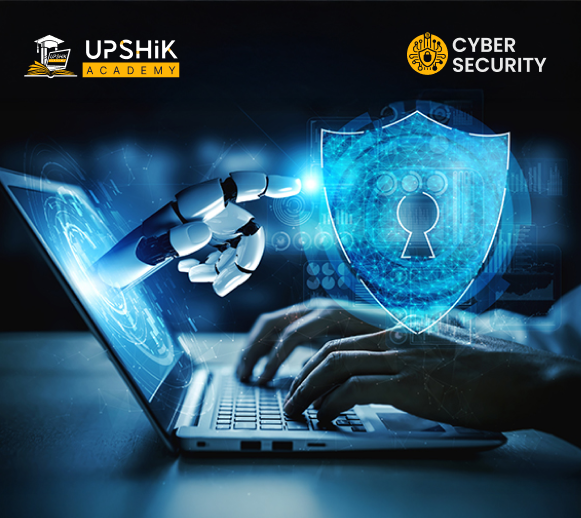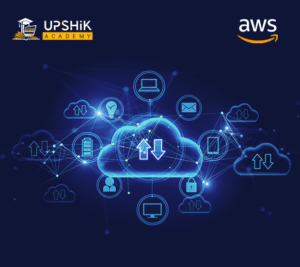
Our Cyber Security course offers hands-on training with real-time labs and expert mentorship. Whether you’re starting your career or upgrading your skills, this course covers both foundational and advanced security practices. From identifying threats to securing enterprise infrastructure, become a …
Our Cyber Security course offers hands-on training with real-time labs and expert mentorship. Whether you’re starting your career or upgrading your skills, this course covers both foundational and advanced security practices. From identifying threats to securing enterprise infrastructure, become a cybersecurity professional with globally recognized certification readiness. Flexible learning, practical approach, and career-oriented outcomes.
Course Overview
UpShik Academy’s Cyber Security Development Course This 4-week beginner-level course offers a comprehensive and hands-on introduction to the world of cybersecurity. Designed for aspiring cybersecurity professionals, IT beginners, and tech enthusiasts, the program progressively builds foundational knowledge and real-world skills required to detect, respond to, and mitigate modern cyber threats.
What You Will Learn
In this comprehensive Cyber Security training program, you will
- Week 1: Cybersecurity Basics
- Week 2: Networking & Network Security
- Week 3: SIEM & Wazuh Basics, Incident Response & Endpoint Security (CrowdStrike)
- Week 4: Real-World Attack Simulations & Capstone Project
Hands-On Tools and Platforms
SIEM (Security Information and Event Management)
SIEM platforms collect and analyze log data from various sources (endpoints, servers, network devices, applications). They provide real-time visibility into security incidents.
Examples:
- Splunk,
- Wazuh,
- IBM QRadar,
- LogRhythm,
- Elastic SIEM
Key Capabilities:
- Log aggregation and correlation
- Alerting on anomalies or rule matches
- Threat hunting with custom queries
- Dashboarding and reporting
1.EDR (Endpoint Detection and Response)
EDR tools monitor endpoint activities to detect and respond to cyber threats.
Examples: CrowdStrike Falcon, SentinelOne, Microsoft Defender for Endpoint, Sophos
Intercept X
Key Capabilities:
- Real-time monitoring of processes and file changes
- Detection of malware, exploits, and ransomware
- Isolation and remediation of infected endpoints
- Threat intelligence integration
2.Network Analyzer Tools
These tools help inspect network traffic to detect anomalies, troubleshoot issues, and uncover potential intrusions.
Examples: Wireshark, Zeek (formerly Bro), tcpdump, SolarWinds NetFlow Analyzer
Key Capabilities:
- Deep packet inspection
- Protocol analysis
- Bandwidth usage monitoring
- Detection of suspicious or unauthorized network behavior
3.Sysinternals Suite
A set of advanced utilities by Microsoft for Windows system diagnostics, monitoring, and troubleshooting.
Examples:
- Process Explorer – Shows detailed info about running processes
- Autoruns – Lists all programs that start with Windows
- Procmon (Process Monitor) – Captures real-time file system, registry, and process/thread activity
- PsExec – Execute processes remotely
Use Cases:
- Malware analysis and detection
- System behavior auditing
- Debugging application issues
Live Projects and Assignments
Yes, Gain real-world experience through
- 2+ Live Cyber Security Projects
- Weekly Assignments and Quizzes
- Performance Optimization Tasks
Target Audience
This course is ideal for:
- College Students & Fresh Graduates
- Aspiring Cybersecurity Professionals
- IT Support / System Administrators
- Security Enthusiasts
- Certification Seekers
- Junior Security Team Members
Certifications Provided
Upon successful completion, students will receive:
- Course Completion Certificate from UpShik Academy
- Isc2 CC
Job Support and Career Guidance
We offer complete career support through:
- This is a skill development,
- Mock Interviews and Resume Building
- Eligible candidates upon completion of Isc2 CC
- will referred in respective job openings at the point of period
Eligibility and Prerequisites
- Basic knowledge of operating systems (Windows/Linux)
- Familiarity with networking fundamentals (TCP/IP, ports, protocols)
- Curiosity to learn and willingness to engage in hands-on labs
- 5 Sections
- 35 Lessons
- 30 Days
- Cybersecurity Basics7
- 1.1Module 1: Introduction to Cybersecurity – What is Cybersecurity? – Importance of Cybersecurity in to Module’s world – CIA Triad (Confidentiality, Integrity, Availability) – Real-world cyber incidents – Q&A
- 1.2Module 2: Threat Landscape & Attack Frameworks – Common threat types: Malware, Phishing, Ransomware – Cyber Kill Chain explained – MITRE ATT&CK Introduction – Case studies of recent attacks
- 1.3Module 3: Security Domains Overview – Network Security – Application Security – Endpoint Security – Cloud Security – Identity & Access Management
- 1.4Module 4: Lab Environment Setup – Intro to VirtualBox / VMware – Installing Kali Linux & Windows 10 VMs – Networking setup between VMs – Snapshot management
- 1.5Module 5: Basic Reconnaissance Techniques – ping, nslookup, traceroute – WHOIS, DNSdumpster – nmap basics (scan types)
- 1.6Module 6: Types of Security Controls – Preventive, Detective, Corrective – Administrative, Physical, Technical Controls – Examples in corporate environments
- 1.7Module 7: Recap and Assignment Brief – Weekly quiz (15 questions) – Assignment: Threat actor scenario analysis – Peer discussion & doubt-clearing
- Networking & Network Security7
- 2.1Module 1: Networking Fundamentals – OSI Model vs TCP/IP – TCP/UDP basics – Common ports & protocols (HTTP, HTTPS, DNS, etc.)
- 2.2Module 2: Network Security Tools and Concepts – Firewalls, IDS, IPS – NAT, DMZ, VLAN – Proxies and Packet Filtering
- 2.3Module 3: Packet Analysis Basics (Wireshark Part 1) – Wireshark Interface overview – Filters and capture process – Analyze HTTP/HTTPS, DNS packets
- 2.4Module 4: Detecting Attacks with Wireshark (Part 2) – ARP spoofing, DNS poisoning – TCP SYN flood – Exporting packet logs
- 2.5Module 5: Traffic Analysis Lab – Live capture of different traffic types – Identify anomalies in network traffic
- 2.6Module 6: Simulated Network Attacks – Simulate DoS using hping3 – MITM using Ettercap or bettercap – Logs and mitigation techniques
- 2.7Module 7: Weekly Review and Assignment – Quiz – Packet analysis exercise submission
- SIEM & Wazuh Basics7
- 3.1Module 1: SIEM Fundamentals – What is SIEM? – Architecture and Flow (Collection, Normalization, Correlation) – Example SIEM tools (Splunk, Wazuh, QRadar)
- 3.2Module 2: Introduction to Wazuh – Architecture – Elastic Stack integration – Manager, Agent, Filebeat overview
- 3.3Module 3: Installing Wazuh – Ubuntu setup for Wazuh manager – Adding agents (Windows & Linux) – Initial troubleshooting tips
- 3.4Module 4: Collecting Logs with Sysmon & Auditd – Sysmon configuration on Windows – Auditd rules on Linux – Sending logs to Wazuh
- 3.5Module 5: File Integrity Monitoring Lab – FIM configuration in Wazuh – Creating file monitoring rules – Validate alerts on file tampering
- 3.6Module 6: Custom Rules & Decoders – Understanding default rule sets – Creating a custom rule – Writing basic decoder for log pattern
- 3.7Module 7: Real-Time Use Cases in Wazuh – Unauthorized login detection – Privilege escalation tracking – Weekly review and Q&A
- Incident Response & Endpoint Security7
- 4.1Module 1: Incident Response Lifecycle – NIST IR Phases – Key roles in IR team – IR documentation & reporting
- 4.2Module 2: Endpoint Security Basics – Difference: AV, EDR, XDR – Host-based protection – IOC vs IOA
- 4.3Module 3: CrowdStrike Falcon Overview – Falcon console tour – Sensor deployment planning – Supported OS and deployment options
- 4.4Module 4: Falcon Sensor Installation – Hands-on sensor install – Basic policy setup – Ensuring sensor visibility
- 4.5Module 5: Falcon Detection Use Case – Simulate malware execution – Observe detections – Alert breakdown
- 4.6Module 6: Ransomware Simulation Lab – Simulate a ransomware dropper – Detection and response in Falcon – Endpoint isolation
- 4.7Module 7: Policy Management and Threat Hunting – Creating/editing prevention policies – Search and filter in Falcon console – Threat Graph overview
- Capstone and Advanced Use Cases7
- 5.1Module 1: Brute Force Attack Simulation – Use hydra for brute-force demo – Detection via Wazuh/Falcon
- 5.2Module 2: Correlating Logs in Wazuh – Multiple source alert correlation – Creating alert rules for log patterns
- 5.3Module 3: Failed Login Detection – Monitor login attempts via Wazuh – Alert response policy creation
- 5.4Module 4: IOC Detection Comparison – Use known malware hash or file – See alert in Wazuh vs CrowdStrike – Response recommendations
- 5.5Module 5: Playbook Development – What is a playbook? – Design a response playbook for phishing & malware
- 5.6Module 6: Final Capstone Project – Assign a threat scenario – Students perform detection, investigation, and response
- 5.7Module 7: Certification, Review, Career Path – Final quiz – Feedback – Career paths: SOC Analyst, IR, Threat Intel – Course certificate distribution
You might be intersted in
Mastering Network Security: Safeguard Systems, Secure Futures
Welcome to UpShik Academy, your premier online EdTech platform dedicated to empowering students and professionals with cutting-edge digital learning and skill development.
- +91 73960 67744
- contact@upshikacademy.com
Quick Links
Courses
Address
- Viswa Bharati Enclave 2nd Floor, Bairagi patteda, Tirupati, Andhra Pradesh 517501
- No 5, 2nd Cross Rd, near Manyata Tech Park Road, P&T Layout, Bengaluru, Karnataka 560077.
- Gronnvej 268, 2nd Sorgenfri Virum -2830 Copenhagen capital region Denmark.
Copyright © Upshik Academy | Developed By ZenWareIT Software Solutions LLP





